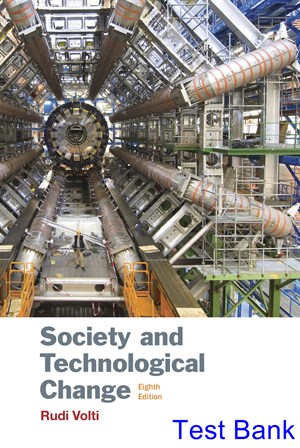This is completed downloadable of Society and Technological Change 8th Edition Volti Test Bank

Product Details:
- ISBN-10 : 1319058256
- ISBN-13 : 978-1319058258
- Author: Rudi Volti
Society and Technological Change is the best text available for undergraduate courses exploring the relationship between societal and technological change Brimming with Rudi Volti’s expertise and enthusiasm for its dynamic subject, this always timely volume helps students grasp the vast societal implications of a wide range of technological breakthroughs, both historic and contemporary.
Table of Content:
- PART ONE: Defining Technology
- Chapter 1: The Nature of Technology
- Defining Technology
- Technological Advance and the Image of Progress
- Technology as a Metaphor
- Technology and Rationality
- Technological Determinism
- Living in a Technological Society
- Questions for Discussion
- Chapter 2: Winners and Losers: The Differential Effects of Technological Change
- Technology as a Subversive Force
- The Luddites
- Neo-Luddism
- Whose Technology?
- What Technology Can Do—And What It Cannot Do
- Questions for Discussion
- PART TWO: The Process of Technological Change
- Chapter 3: The Sources of Technological Change
- Technological Change as a Social Process
- The Great Breakthrough
- The “D” in R&D
- Putting It All Together
- Clearing Bottlenecks through Technology Transfer
- Supply and Demand: The “Push” and the “Pull”
- Belated Demand: The Question of Market Timing
- How Market Economies Drive Technological Innovation
- Obstacles to Innovation in Centrally Planned Economies
- Noneconomic Sources of Technological Advance
- Questions for Discussion
- Chapter 4: Scientific Knowledge and Technological Advance
- The Historical Separation of Science and Technology
- Studies of Contemporary Science–Technology Relationships
- How Technology Differs from Science
- How Technology Facilitates Scientific Discovery
- Legitimating Science through Technology
- The Translation of Science into Technology
- The Commonalities of Science and Technology
- Questions for Discussion
- Chapter 5: The Diffusion of Technology
- Technology on the Move
- Clever Copyists
- Adaptation and Adoption
- Learning to Make Steel in Old Japan
- Appropriate Technology
- Organizations and Technological Diffusion
- A Risky Business
- The NIH Syndrome
- Efforts to Restrict the Diffusion of Technology
- Patents and the Diffusion of Technology
- Questions for Discussion
- PART THREE: How Technology Affects the Health of Earth and Its Inhabitants
- Chapter 6: Technology, Energy, and the Environment
- Fossil Fuels, Air Pollution, and Climate Change
- A Planet under Stress
- Is Technology the Problem or the Solution?
- Some Technological Fixes of the Past
- Alternatives to Fossil Fuels
- Doing More with Less
- More Miles to the Gallon
- Economic Systems, Government Policies, and the Environment
- Questions for Discussion
- Chapter 7: Medical Technologies
- New Medical Technologies: Choices and Trade-offs
- The Case of Kidney Dialysis
- Replacing Broken Hearts
- Diagnostic Technologies
- Medical Technologies and Medical Ethics
- New Ways of Making and Sustaining Babies
- When Does Life End? When Should It?
- Halfway Technologies
- Questions for Discussion
- Chapter 8: Genetic Technologies
- The Genetic Fix
- Discovering Genes and Patenting Them
- Bioengineering on the Farm
- Genetic Mapping and Screening
- Cloning, Present and Future
- Stem Cells and Future Therapies
- The Perils of Genetic Intervention
- Questions for Discussion
- PART FOUR: Technology and the Transformation of Work
- Chapter 9: Work in Nonindustrial Societies
- Working with the Earliest Tools
- Work and Leisure in Technologically Primitive Societies
- Work and the Development of Agriculture
- Farming Techniques and Patterns of Work
- The Ironies of Progress
- Urbanization, Specialization, and Economic Relationships
- Guild Organization and Technological Change
- Slavery and the Inhibition of Technological Development
- The Measurement of Time and Changed Working Patterns
- The Clock
- Questions for Discussion
- Chapter 10: Technology and Jobs: More of One and Less of the Other?
- The Technological Threat in Historical Perspective
- A Case for Optimism
- How Technology Creates Jobs
- The Indirect Effects of New Technologies on Employment
- The Machines Aren’t Ready to Take Over
- Technology, Jobs, and the Changing Structure of the Economy
- Technology and the Distribution of Income
- Technology, Globalization, and Jobs
- Rebounding from Job Losses
- Benefits, but Disruption Too
- Questions for Discussion
- Chapter 11: Technological Change and Life on the Job
- Industrial Production
- Machine-Paced Labor
- Is Technology to Blame?
- Industrial Technology and the Division of Labor
- Scientific Management Once Again
- Industrial Work and Recent Technological Developments
- Technological Change and White-Collar Work
- Telework
- The “Gig Economy”
- Smart Technologies and Dumb Jobs?
- Questions for Discussion
- PART FIVE: Communication
- Chapter 12: Printing
- The Printing Revolution
- Printing and the Expansion of Knowledge
- Printing and the Rise of Protestantism
- Printing, Literacy, and Social Change
- Psychological Effects of Printing
- Newspapers
- Digitizing the News
- Reading Digitally
- Questions for Discussion
- Chapter 13: The Electronic Media: From the Telegraph to Television
- The Invention of Radio
- The Origins of Commercial Radio
- The Rise of Television
- The Federal Government Steps In
- The Television-Viewing Public
- Violence on Television and Its Consequences
- Delivering the News
- Television and Politics
- Television and Thought
- Questions for Discussion
- Chapter 14: The Internet Age
- The Birth and Growth of the Internet
- Social Media and the Network Effect
- Mobile Communications
- Social Media and Social Movements
- The Digital Divide
- Video Games
- Intellectual Property
- Privacy in the Digital Age
- The Electronic Media in Modern Society
- Questions for Discussion
- PART SIX: The Tools of Destruction
- Chapter 15: Weapons and Their Consequences
- Military Technology in the Ancient World
- Military Technology and the Feudal Order
- New Weapons and the Decline of Feudalism
- The Gunpowder Revolution
- War and the Centralized State
- Technological Change and Naval Culture in the Era of the Battleship
- Weapons and the Making of the Modern World
- Questions for Discussion
- Chapter 16: The Era of Smart Weapons
- Cruise Missiles
- Smart Bombs
- High-Tech Surveillance
- Drones
- The Cost of Technological Sophistication
- Asymmetrical Warfare
- Cyberterrorism and Cyberattacks
- Military Technologies in a Changing World
- Questions for Discussion
- Chapter 17: How New Weapons Emerge—And How They May Be Contained
- Action and Reaction
- Social Structure and the Development of Military Technologies
- Expanding the Scale and Scope of War
- Industrial Technology in the Service of War
- Controlling Military Technologies
- The Perils of Proliferation
- Questions for Discussion
- PART SEVEN: The Shaping and Control of Technology
- Chapter 18: Technology and Its Creators: Who’s in Charge of Whom?
- Technological Advance and Cultural Lag
- Technology, Globalization, and Cultural Convergence
- Experts, Expertise, and the Shaping of Technology
- Engineers and the Control of Technology
- Questions for Discussion
- Chapter 19: Organizations and Technological Change
- Technology as a Cause of Organizational Structure
- Technology as a Consequence of Organizational Structure
- Organizational Size and Technological Innovation
- Organizations and New Information Technologies
- Interorganizational Relations and Technological Development
- Entrepreneurs and Organizations
- Questions for Discussion
- Chapter 20: Governing Technology
- Government Actions and the Shaping of Technology
- Paying for Science and Technology
- But Is It Really Necessary?
- Government Institutions for the Guidance of Technology
- How Government Policies Shape Technological Change
- The Democratic Control of Technology
- The Challenges of the Future
- Questions for Discussion
- Notes
- Index





